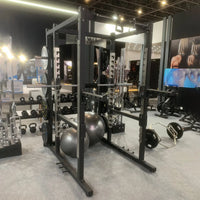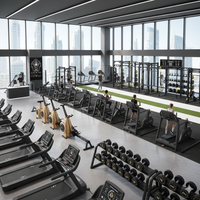When it comes to achieving optimal fitness, both Pilates and traditional strength training offer valuable (but very different) paths. One emphasizes controlled, low-impact movements rooted in alignment and flexibility. The other builds power, muscle mass, and endurance using resistance and load progression.
But whether you're designing a commercial fitness space, planning a boutique studio, or deciding which discipline suits your goals, understanding the equipment needs of both systems is essential.
This guide explores how Pilates and traditional strength training differ in terms of purpose, equipment, and integration within a commercial gym equipment setup.
1. Purpose & Training Philosophy: Stability vs. Strength
✅ Pilates
-
Focuses on core control, alignment, and mobility
-
Uses spring-based resistance, bodyweight, and precision
-
Ideal for rehabilitation, flexibility, and postural correction
✅ Strength Training
-
Centers on progressive overload for muscle hypertrophy and strength gains
-
Utilizes weights, machines, and resistance bands
-
Effective for building raw power and muscular endurance
The training goals define the equipment. Pilates aims to sculpt and stabilize. Strength training aims to grow and load.
2. Core Equipment for Pilates: Controlled Resistance and Flow
Pilates equipment is designed to support fluid, low-impact movement patterns that strengthen the body from the inside out.
🔹 Reformer Machines
-
Sliding carriage, adjustable springs, and straps
-
Builds strength while maintaining joint integrity
-
Perfect for core training, leg work, and mobility
🔹 Pilates Tower or Cadillac
-
Supports suspension work, flexibility, and spine mobility
-
Offers vertical movement and support for all levels
🔹 Wunda Chair & Spine Corrector
-
Compact tools for seated, standing, and spinal extension exercises
🔹 Mat & Small Props
-
Resistance rings, Pilates balls, bands, and rollers for precision control
Most commercial gym equipment suppliers now offer durable, commercial-grade Pilates reformers that are ideal for group settings or hybrid studios.
3. Core Equipment for Strength Training: Load and Progression
Strength equipment focuses on overload and resistance to push muscles beyond their comfort zone.
🔹 Free Weights (Dumbbells, Barbells, Kettlebells)
-
Essential for compound lifts like squats, deadlifts, and presses
-
Allow for dynamic and functional strength training
🔹 Weight Benches & Power Racks
-
Versatile for upper/lower body training
-
Support advanced lifting with safety bars and adjustability
🔹 Resistance Machines
-
Plate-loaded or pin-loaded for isolation work
-
Safer for beginners or rehab clients
🔹 Cable Machines / Functional Trainers
-
Great for strength and rehab
-
Adjustable angles replicate real-life movement patterns
This commercial gym equipment is built to withstand high traffic and heavy loads, making it a cornerstone of any professional facility.
4. Flexibility & Mobility Equipment: A Shared Middle Ground
Though Pilates is synonymous with flexibility, both systems benefit from gym flexibility equipment that supports recovery and joint health.
Useful in both:
-
Foam rollers and trigger point balls (myofascial release)
-
Stretching straps and bands
-
Slant boards for ankle and knee mobility
-
Stability balls and balance discs
Commercial gyms that combine strength and Pilates benefit from a mobility zone stocked with these tools, bridging the gap between muscle work and joint care.
5. Space and Layout Considerations
💠 Pilates Equipment Needs
-
Requires more floor space per person due to reformers or towers
-
Needs mirrors, natural lighting, and a calm environment
-
Often arranged in dedicated zones for low-noise flow
💠 Strength Equipment Needs
-
Requires heavy-duty flooring for weight drops
-
Compact benches and racks can be placed close together
-
Works well in high-energy, industrial-style layouts
If you’re planning a mixed-use space, allocate separate areas for Pilates and strength to accommodate their different movement styles and noise levels.
6. Integration: Can You Combine Both?
Absolutely. In fact, many modern fitness centers blend Pilates and strength equipment to offer hybrid programming. Examples:
-
Pilates for warm-ups and postural alignment, followed by strength circuits
-
TRX and cable machines paired with reformer workouts
-
Pilates core sessions for lifters recovering from injury
This dual approach appeals to athletes, older adults, and fitness seekers who want both strength and mobility in one membership.
Conclusion: Equip Your Gym for the Future of Functional Fitness
Choosing between Pilates and traditional strength training isn't an either-or decision. They complement each other beautifully when paired with the right equipment. For a commercial gym, offering both means expanding your market—from lifters seeking better recovery to Pilates fans looking to build real-world strength.
When shopping for gear, work with suppliers that understand both sides—from Pilates reformers to barbell racks and gym flexibility equipment. It’s this integration that future-proofs your gym and delivers a balanced fitness experience to all users.




0 comments